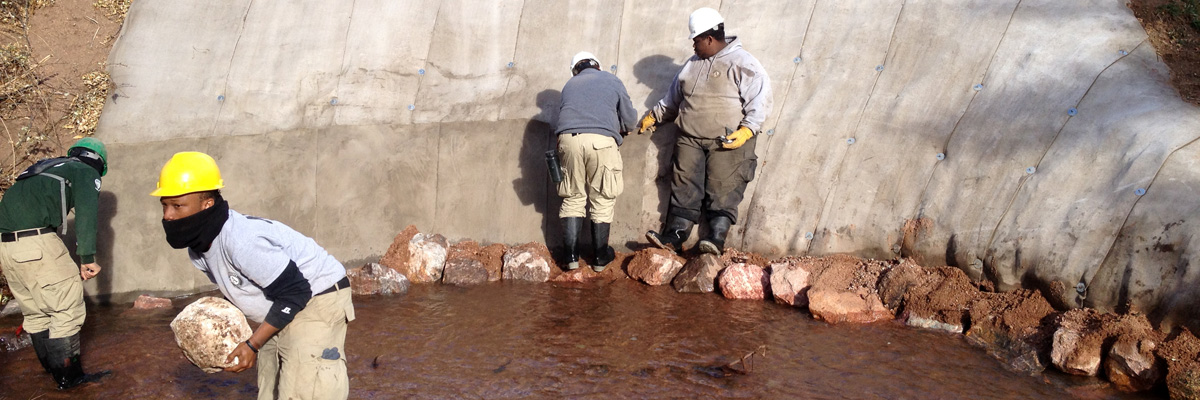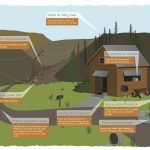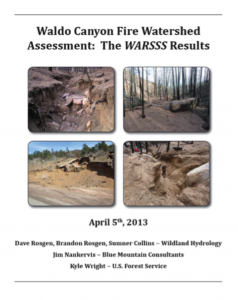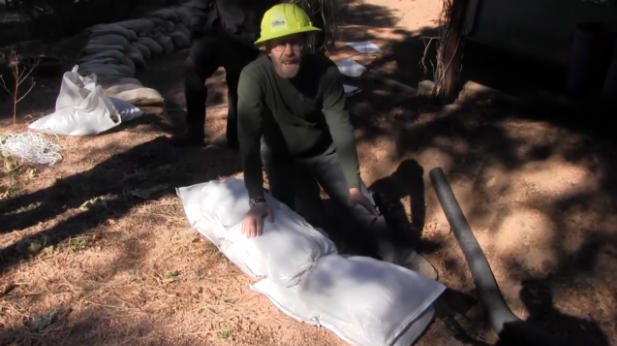
Low-intensity fires were the natural norm before settlers prevented fires from burning to protect their homes, land, and assets. These fires cleared out undergrowth, opened up forest canopies, and recycled nutrients back into the soil to provide more diverse habitat for wildlife, more room and nutrients for trees to grow strong, and rejuvenated forests.
The intense conflagrations we see today are a product of the unhealthy, man-made forests we have inadvertently shaped over many decades. After these large wildfires, surrounding communities and impacted watersheds experience devastating flooding, soil loss, and water quality degradation. Restoring these burn scars is a decades-long process involving flood mitigation, re-vegetation, river restoration, and strong community support and commitment.
Floods follow wildfire.
The drastic changes on the landscape after catastrophic wildfires, like the 2002 Hayman Fire and the 2012 Waldo Canyon Fire, affects ecosystems and how water moves across the land. High intensity wildfires scorch soil and greatly reduce the amount of vegetation on hillslopes. When rain comes down over the burn scar, these barren slopes allow water to move quickly downhill because very little stands in the way to slow down the flow or absorb the water. The steep mountainsides and highly erosive granite soils found in our region further complicate problems with flooding. As more water rushes down and picks up speed, it is collecting sediment and debris. These debris-laden floodwaters are highly destructive to anything in their path, including homes, habitats, and streams.
As the water seeks out the path of least resistance, waterways and areas on the hillsides suffer from increased erosion. The rates of sediment movement in post-wildfire environments are unsustainable and can greatly alter the hydrology of burn scars and areas downstream. Amplified flooding and debris flows threaten lives, property, infrastructure, and habitats for years after a catastrophic fire.
CUSP has long recognized the connections between fires, floods, and watershed impacts. While we focus on proactively working with communities to improve forest conditions before intense wildfires spark, we have also become adept at quickly responding to wildfire. After catastrophic fires, we work across jurisdictional boundaries with government agencies, private landowners, other nonprofits, and local leadership to quickly help communities prepare for flooding and implement emergency stabilization projects that mitigate post-fire flooding, protect lives and property, and jump-start the healing process across the landscape. We prioritize flood mitigation work to protect communities, water sources, infrastructure, and other high values at risk using flood mitigation techniques that work with nature to return natural floodplains and vegetation to the landscape for short-term mitigation and long-term recovery.
Understanding that wildfire recovery is a long-term process that takes decades, we work with communities and other partners to ensure emergency stabilization efforts are followed by restoration projects that continue to promote healthy regrowth of burned areas and protect watersheds and communities from erosion and flooding threats. Wildfire recovery provides a unique opportunity for communities to come together to become more resilient and grow stronger while improving the health of the forests where they live after a devastating disaster.
Wildfire recovery and flood mitigation is critical for protecting lives, property, infrastructure, and water quality. Support this high priority work today by donating or signing up to volunteer.
Learn more:
Post-Fire/Recovery Information Available
After a catastrophic wildfire, quick action must be taken to minimize social, environmental, and economic devastation. Given enough time, forests eventually heal from wildfire, but that healing process can take decades or even centuries. The landscape won’t heal quickly without human intervention. Timely rehabilitation efforts can reduce the environmental impacts of fire, and can have a positive impact on the community’s social and economic situation in the months and years after the fire.
Waldo Canyon Fire Assessment & Restoration Master Plan
The Waldo Canyon Fire Watershed Assessment of River Stability and Sediment Supply (WARSSS) provides the scientific basis for prioritizing flood mitigation and restoration projects in the aftermath of the fire. The Waldo Canyon Fire Master Plan for Watershed Restoration & Sediment Reduction makes specific restoration recommendations based on the findings in the Waldo Canyon Fire WARSSS. These documents are critical for the collaborative planning and implementation of post-fire restoration efforts by public and private partners.
This handbook is intended to provide Conservation Districts, nonprofit groups, and communities with a step-by-step guide to use in developing a post-fire recovery and rehabilitation plan. It addresses, with examples and resource materials, issues such as who to involve in developing a plan, how to engage other interested parties, what elements to consider in assessing post-fire risks and priorities, and how to develop a mitigation or recovery plan to address those risks. We hope it will prove useful in helping your community establish plans and priorities that protect its citizens, homes, and essential infrastructure and resources from the destruction that can occur after a catastrophic wildfire.
This instructional video was produced by the Colorado Springs Gazette and shows our own Jeff Ravage demonstrating how to properly build a sandbag wall. Watch the video >>




